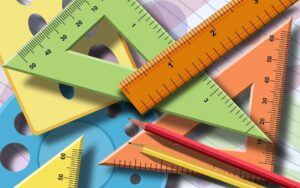Mathematics of the Ancient East
Mathematics is the science which investigates the quantitative characteristics and abstract forms of the material world. To put it differently, mathematics can be understood as the science of relations among those or other objects about which there is no information other than the properties that characterize them. Directly, these structural types form the basis of set theory as postulates. These postulates correspond to first grade go math.
A clearer understanding of mathematics, as a non-ordinary paradigm which has its own tactics and essence, developed more readily after the accumulation of quite enormous information and first appeared in Ancient Greece in the fifth and sixth century.
Up to that time, the formation of mathematics can certainly be attributed to the phase of the formation of mathematics, and to the V- VI century tie the eve of the era of elementary mathematics, which lasted until about 16 century. Mathematical studies had rather compressed resources of fundamental concepts during these phases of time. These concepts emerged sufficiently in the initial stages of historical progress together with the elementary demands of the agricultural existence of the population, which is expressed in the establishment of food indicators, to the calculation of objects, areas of land, finding the individual composition of architectural structures, the recognition of duration, navigation, dealer calculations, 2nd grade go math etc.
The first mathematical tasks, apart from the individual studies of Archimedes, which already needed the basics of calculating infinitesimals, could also be satisfied with the resources of basic mathematics.
One of the outstanding sciences was astronomy, and it was the source of the early development of trigonometry. Long before the larger development of mathematical cognition of the phenomena of nature in the 17th and 18th centuries, astronomy had high and special demands on mathematical science.
The renewed demands of technology and natural science prompted mathematicians of the time to turn more attention to the development of such techniques that would allow more accurate mathematical studies of the change of magnitudes, motion, as well as various transformations of geometric figures.
Later, more in-depth study of quantitative characteristics and abstract forms, which mathematics studies, led to the necessity of approaching the essence of mathematical science more consciously, defining the goal of systematic familiarization of admissible forms of quantitative characteristics and abstract forms as well as release go math 3 grade.
N. I. Lobachevsky made a significant step in the mathematical direction by developing “imaginary geometry,” which received realistic use. It was this kind of work that introduced quite substantial features into the science of mathematics. That is why mathematics of the 19th and 20th centuries is peculiarly classified as a special period of modern mathematics.
Our first understanding of forms and numbers is associated primarily with the era of the ancient Stone Age, as it is also called – Paleolithic. The most ancient people of that time differed little from animals, they lived in caves, and their life force went mainly to the extraction of food, which was obtained in a fairly simple way – gathering. People engaged in the production of tools, tried to talk to each other, thereby developing a human language. In the late Stone Age, they made things to decorate their places of existence with, made various drawings and figures, i.e. practiced a kind of art. It was in these drawings and figurines that a kind of form was discovered.
Gradually, people moved from the usual gathering of food to a more active production of it, from fishing and hunting to farming. People began to advance in their knowledge of numbers and spatial relationships. With the onset of this revolution, human inactivity toward nature began to be replaced by enterprise, leading to a new Stone Age era, the Neolithic.
Subsequently, simple crafts began to form: weaving, pottery, carpentry. There were barns at the time, so people could stockpile food for the winter or in case of crop failure. In the late Stone Age, people were able to smelt and work metal. There were also discoveries such as the invention of the cartwheel and the potter’s wheel. Dwellings and boats were improved. Also, trade was actively developing a lot of commercial relations between areas that were hundreds of thousands of miles from each other. As a consequence of all this, the language of the peoples was formed. The words people used stated specific objects and philosophical concepts. Languages by then were known to have words for elementary numerical concepts.
Numerical concepts gradually came into use. At first they emerged as qualitative rather than quantitative, revealing differences between one, two, and many. At first, large numbers were obtained by adding simpler numbers, as, for example: 6 was obtained by adding the numbers 3 and 3, or 5 and 1, 4 and 2; the number 8, for example, could be obtained by adding 4 and 4, 3 and 5, 2 and 6, etc.
Numerical concepts gradually came into use. At first they emerged as qualitative rather than quantitative, revealing differences between one, two and many. At first, large numbers were obtained by adding simpler numbers, as, for example: 6 was obtained by adding the numbers 3 and 3, or 5 and 1, 4 and 2; the number 8, for example, could be obtained by adding 4 and 4, 3 and 5, 2 and 6, etc.
An example of the numbering of certain peoples of Australia:
Kamilaroi: 1 = Mal, 2 = Bulan, 3 = Guliba, 4 = Bulan-Bulan, 5 = Bulan-Guliba, 6 = Guliba-Guliba.
Murray River Tribe: 1 = enaea, 2 = petcheval, 3 = petcheval-enaea, 4 = petcheval-petcheval.
With the advancement of trade and craft there was the formation of the representation of numbers. The numbers were classified into larger units, using the fingers on the hand, so, for example, was the calculation in trade. Counting was done by first taking 5, then 10, and so on, supplemented by subtraction or addition of simpler numbers. Therefore, number 11 could be represented as 5+6, number 1 as 10-9.
Sometimes the basis was the number 20 – the number of toes and hands. Of the 307 orders of calculation of the prehistoric peoples of America, mastered by Iles, 146 were decimal, 106 were five and five-ten, others were twenty and five-twenty. Notes of numbers were recorded by means of knots on ropes, stones and shells, bundles, and notches on canes.
The concepts of arithmetic of natural numbers were created by counting things in the early stages of cultural formation. The system of oral numbering gave rise to a system of written numbering, then developed methods for performing the four mathematical operations on natural numbers.
The need to measure the number of any objects leads to the emergence of signs and names for fractional numbers and the creation of arithmetic techniques over fractions. From this comes the accumulation of information, which is transformed into such a mathematical science as arithmetic. Also arises the need to measure the areas, volumes of certain objects – this gives rise to the geometric science.
Acquisition of geometric and arithmetic knowledge entailed a significant role in the advancement of science in Babylon and Ancient Egypt. In Babylon, arithmetic calculus gave rise to the beginnings of algebra; astronomy, in turn, gave the rudiments of trigonometry.
The texts of mathematics in ancient Egypt at the time consisted of examples for solving individual problems or tips for solutions, which can only be understood by examining these examples in the texts provided. They were usually paired with an answer check.
The peoples of Egypt developed a heavy apparatus of processes with fractions, which needed special additional tables. The processes of bifurcation and doubling of integers were important. These processes reached into medieval Europe through the order of preliminary links.
Problems of finding unknowns in the form of equations were regularly solved. Geometry consisted of correctly finding the volumes and areas of figures such as trapezoids, triangles, pyramid volumes, and parallelepipeds. A great achievement with the Egyptians was the method of calculating the volume of a truncated pyramid with a square base:
V = h/3(a(2)+ab+b(2))
All this indicated that mathematical inference began to form in Egyptian mathematics.
There are many more mathematical texts in Babylon than in Egypt. They predate the emergence of Greek mathematics. The first such texts are attributed to the heyday of mathematics in Babylon, but despite the presence of some innovations, later mathematical texts show a halt in Babylonian mathematics.

Recent Comments